Spatial Heterogeneity in Chinese Forest Area Change in the Early 21st Century
Abstract
:1. Introduction
2. Data and Methods
2.1. Data Collection
2.1.1. Land Cover Data
2.1.2. Forestry Division Data
2.1.3. Environment Data
2.1.4. Socioeconomic Data
2.2. Accuracy Assessment
2.3. Spatial Clustering Distribution Analysis
2.4. Driving Model of Forest Change
3. Analyses and Results
3.1. Geographical Distribution and Characteristics of Forest Variation in China
3.2. Relationships between Forest Area Changes and Natural Factors
3.3. Transitions between Forest and Other Land Use Types
3.4. Relationships between Forest Area Changes and Socioeconomic Development
4. Conclusions and Discussion
Acknowledgments
Author Contributions
Conflicts of Interest
Abbreviations
| GDP | Gross Domestic Product |
| EKC | Environmental Kuznets Curve |
| DEM | Digital Elevation Model |
References
- Food and Agriculture Organization of the United Nations. Main Report: Global Forest Resource Assessment; FAO: Rome, Italy, 2010. [Google Scholar]
- Foley, J.A.; DeFries, R.; Asner, G.P.; Barford, C.; Bonan, G.; Carpenter, S.R.; Chapin, F.S.; Coe, M.T.; Daily, G.C.; Gibbs, H.K.; et al. Global consequences of land use. Science 2005, 309, 570–574. [Google Scholar] [CrossRef] [PubMed]
- Mather, A.S. The forest transition. Area 1992, 24, 367–379. [Google Scholar]
- Mather, A.S. Recent Asian forest transitions in relation to forest transition theory. Int. For. Rev. 2007, 9, 491–501. [Google Scholar]
- Barbier, E.B.; Burgess, J.C.; Grainger, A. The forest transition: Towards a more comprehensive theoretical framework. Land Use Policy 2010, 27, 98–107. [Google Scholar] [CrossRef]
- Grainger, A. The forest transition: An alternative approach. Area 1995, 27, 242–251. [Google Scholar]
- Zhang, Y.; Tachibana, S.; Nagata, S. Impact of socio-economic factors on the changes in forest areas in China. For. Policy Econ. 2006, 9, 63–76. [Google Scholar] [CrossRef]
- Lambin, E.F.; Meyfroidt, P. Land use transitions: Socio-ecological feedback versus socio-economic change. Land Use Policy 2010, 27, 108–118. [Google Scholar] [CrossRef]
- Li, X.B.; Zhao, Y.L. Forest transition, agricultural land marginalization and ecological restoration. China Popul. Res. Environ. 2011, 21, 91–95. [Google Scholar]
- Fang, J.Y.; Guo, Z.D.; Amp, S.L.; Chen, A.P. Terrestrial vegetation carbon sinks in China, 1981–2000. Sci. China Ser. D Earth Sci. 2007, 50, 1341–1350. [Google Scholar] [CrossRef]
- Liu, S.N.; Zhou, T.; Wei, L.Y.; Shu, Y. The spatial distribution of forest carbon sinks and sources in China. Chin. Sci. Bull. 2012, 57, 1699–1707. [Google Scholar] [CrossRef]
- Wang, D.; Wang, B.; Niu, X. Forest carbon sequestration in China and its benefits. Scand. J. For. Res. 2014, 29, 51–59. [Google Scholar] [CrossRef]
- Ma, X.Z.; Wang, Z. Estimation of provincial forest carbon sink capacities in Chinese mainland. Chin. Sci. Bull. 2011, 56, 433–439. [Google Scholar] [CrossRef]
- Wang, S.; Liu, C.; Wilson, B. Is China in a later stage of a U-shaped forest resource curve—A re-examination of empirical evidence. For. Policy Econ. 2007, 10, 1–6. [Google Scholar] [CrossRef]
- Liu, C.; Lv, J.Z. Study on China’s forest resource environmental Kuznets curve. Res. Inst. Econ. 2010, 28, 138–161. [Google Scholar]
- Hu, A.G.; Shen, R.M.; Lang, X.J. Verification of the environmental Kuznets curve relationship between changes in China’s forest resources and economic development: Based on provincial panel data from the second to the seventh national forest statistics. China Publ. Admin. Rev. 2013, 15, 61–75. [Google Scholar]
- Zhang, D.; Stenger, A.; Haroud, P.A. Policy instruments for developing planted forests: Theory and practices in China, the U.S., Brazil, and France. J. For. Econ. 2015, 21, 223–237. [Google Scholar] [CrossRef]
- Zhang, Y.Q.; Uusivuori, J.; Kuuluvainen, J. Impacts of economic reforms on rural forestry in China. For. Policy Econ. 2000, 1, 27–40. [Google Scholar] [CrossRef]
- Deng, X.Z.; Jiang, Q.O.; Zhan, J.Y.; He, S.J.; Lin, Y.Z. Causes and trends of forestry area change in northeast China. Acta Geogr. Sin. 2010, 65, 224–234. [Google Scholar]
- Ge, Q.S.; Zhao, M.C.; Zhang, X.Q.; Zheng, J.Y.; Sun, H.N.; Zhang, P.Y. Statistical analysis about the changes of forest resource and precipitation in China over the past 50 years. J. Nat. Res. 2001, 16, 413–419. [Google Scholar]
- Wang, H.; Lü, Z.; Gu, L.; Wen, C. Observations of China’s forest change (2000–2013) based on the Global Forest Watch dataset. Biodivers. Sci. 2015, 23, 575–582. [Google Scholar] [CrossRef]
- Chen, J.; Chen, J.; Liao, A.P.; Cao, X.; Chen, L.J.; Chen, X.H.; Peng, S.; Han, G.; Zhang, H.W.; He, C.Y.; et al. Concepts and key techniques for 30 m global land cover mapping. Acta Geod. Cartogr. Sin. 2014, 43, 551–557. [Google Scholar]
- Office of Forest Division, Ministry of Forestry. Forest Division of China; Forestry Publishing House: Beijing, China, 1987.
- Sunderlin, W.D.; Resosudarmo, I.A.P. The effect of population and migration on forest cover in Indonesia. J. Environ. Dev. 1999, 8, 152–169. [Google Scholar] [CrossRef]
- Robinson, B.E.; Holland, M.B.; Naughton-Treves, L. Does secure land tenure save forests? A meta-analysis of the relationship between land tenure and tropical deforestation. Glob. Environ. Chang. 2014, 29, 281–293. [Google Scholar] [CrossRef]
- Yang, H.; Nie, Y.; Ji, C. Study on China’s timber resource shortage and import structure: Natural forest protection program outlook, 1998 to 2008. For. Prod. J. 2010, 60, 408–414. [Google Scholar] [CrossRef] [Green Version]
- Marisol, T.; Poorter, L.; Peña-Claros, M. Climate is a stronger driver of tree and forest growth rates than soil and disturbance. J. Ecol. 2010, 99, 254–264. [Google Scholar]
- Rudel, T.K.; Coomes, O.T.; Moran, E.; Achard, F.; Angelsen, A.; Xu, J.C.; Lambin, E. Forest transitions: Towards a global understanding of land use change. Glob. Environ. Chang. 2005, 15, 23–31. [Google Scholar] [CrossRef]
- Zhang, W.; Wang, X.K.; Liu, B.; Zhang, C.; Lai, C.H. Analysis on the dynamic change of Sichuan forest resources in the last thirty years (1979 to 2007). Sichuan For. Explor. Des. 2013, 1, 7–12. [Google Scholar]
- Li, Y. Analysis of forest resources change and development trend in Sichuan forest region. For. Sci. Tech. 2000, 7, 25–27. [Google Scholar]
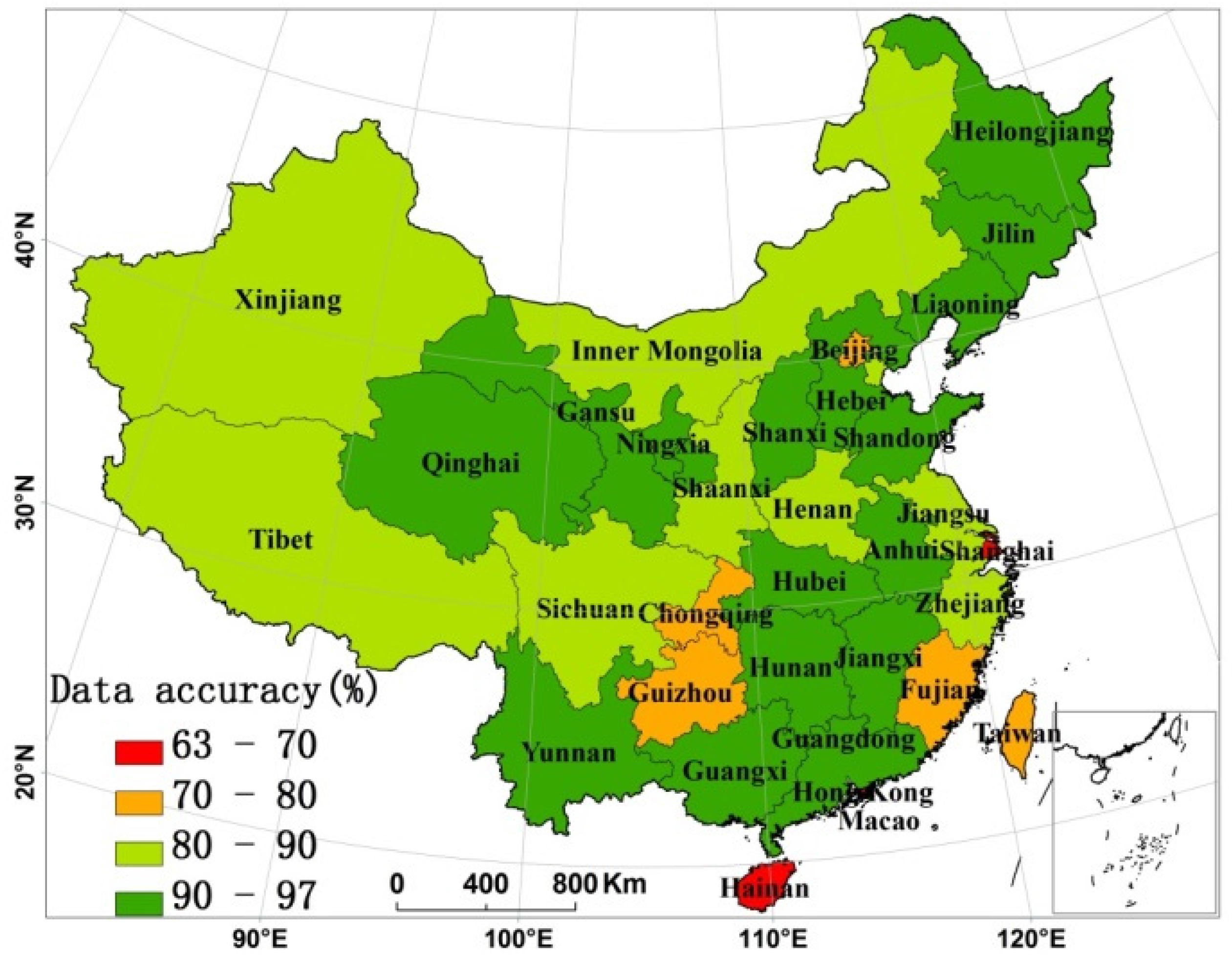
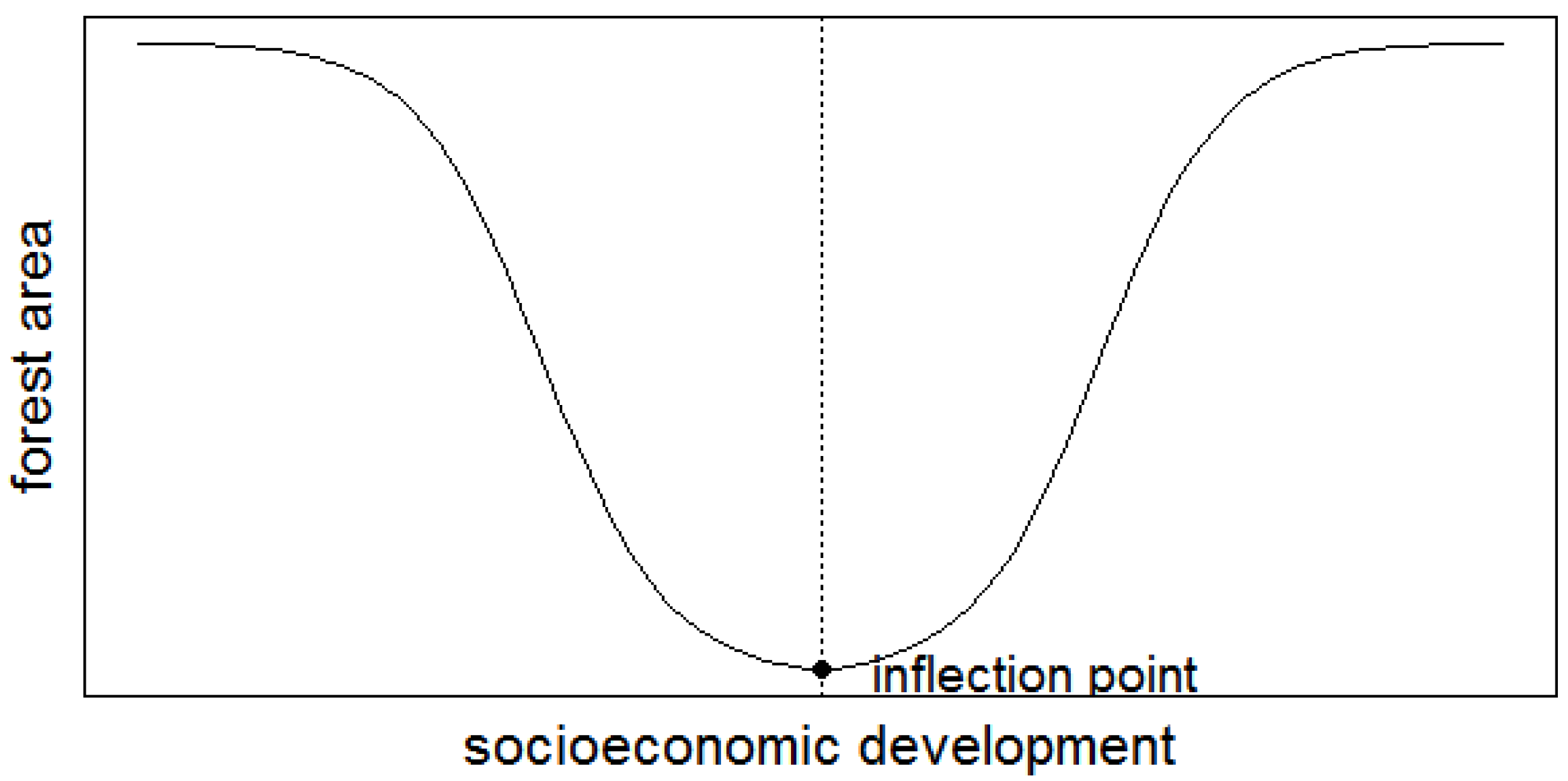


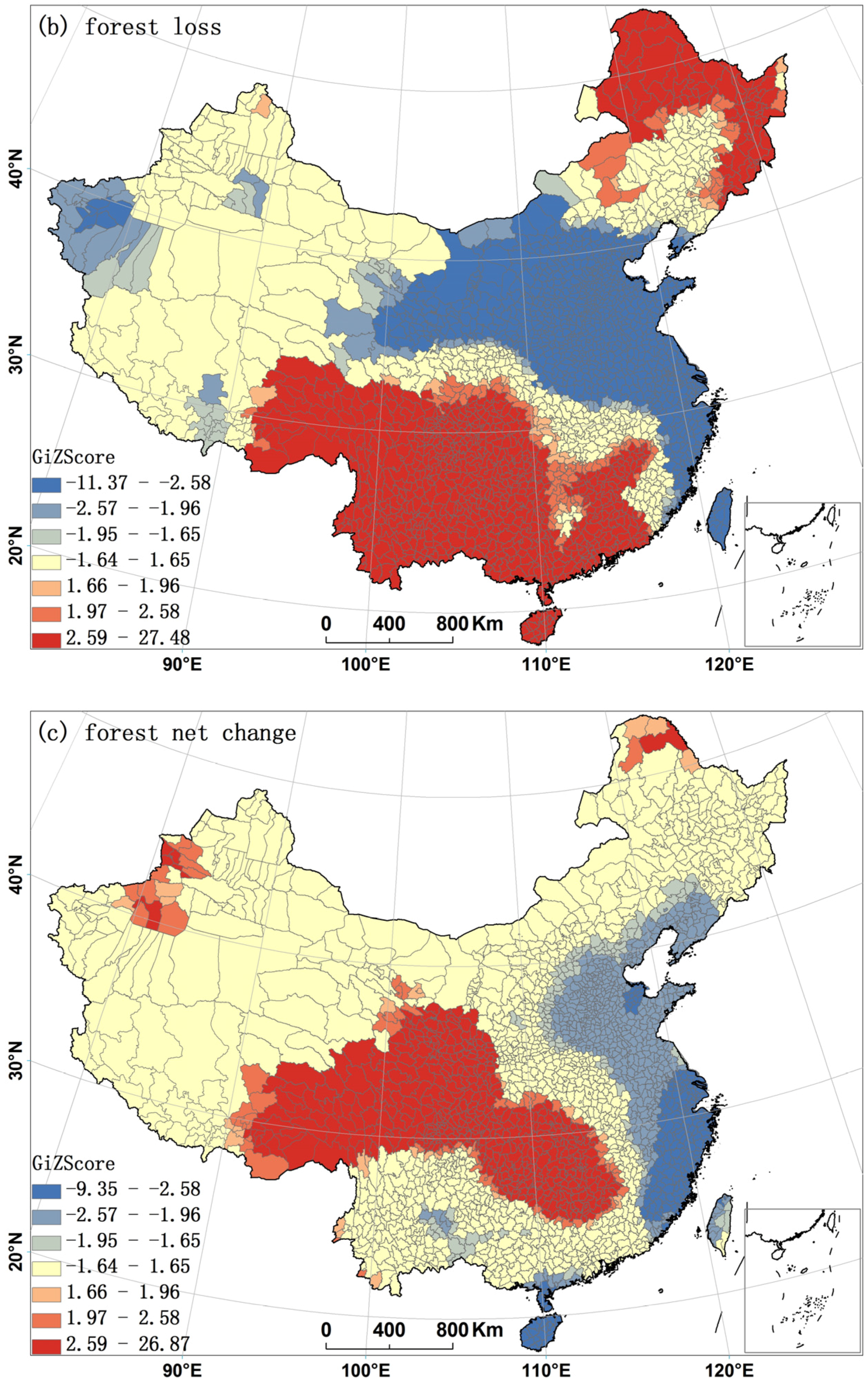
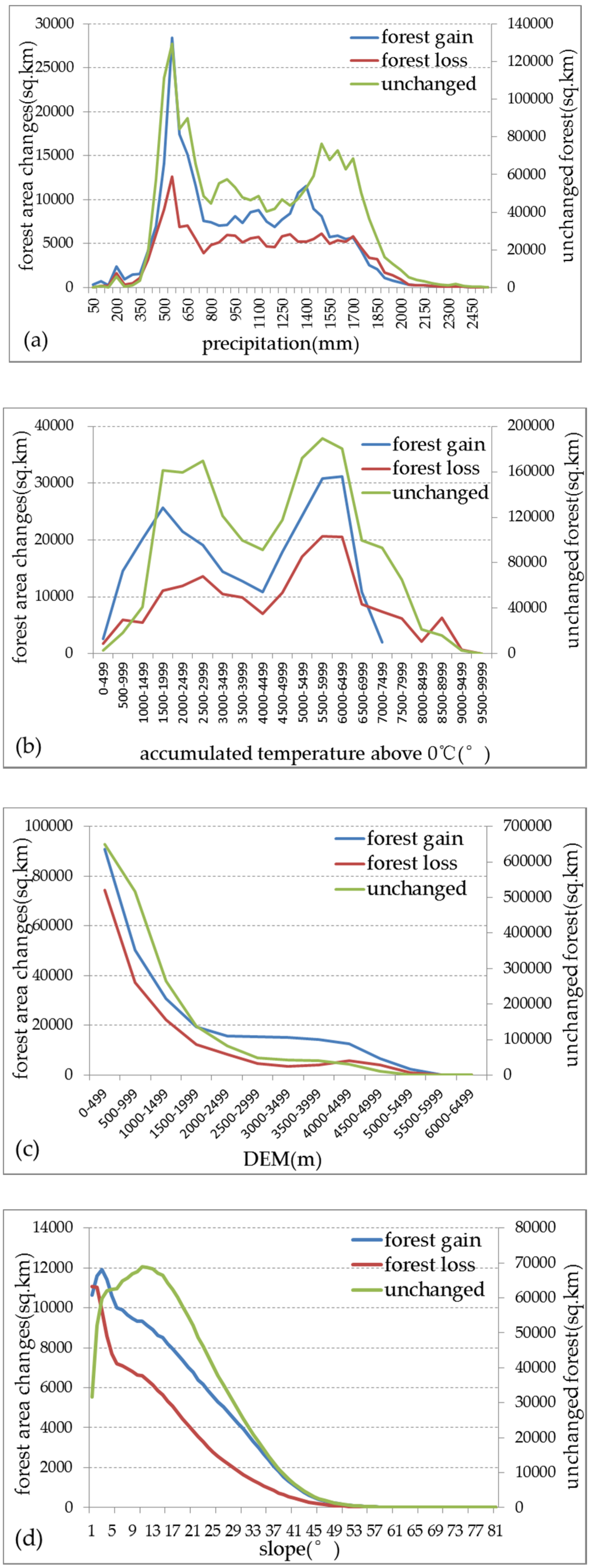
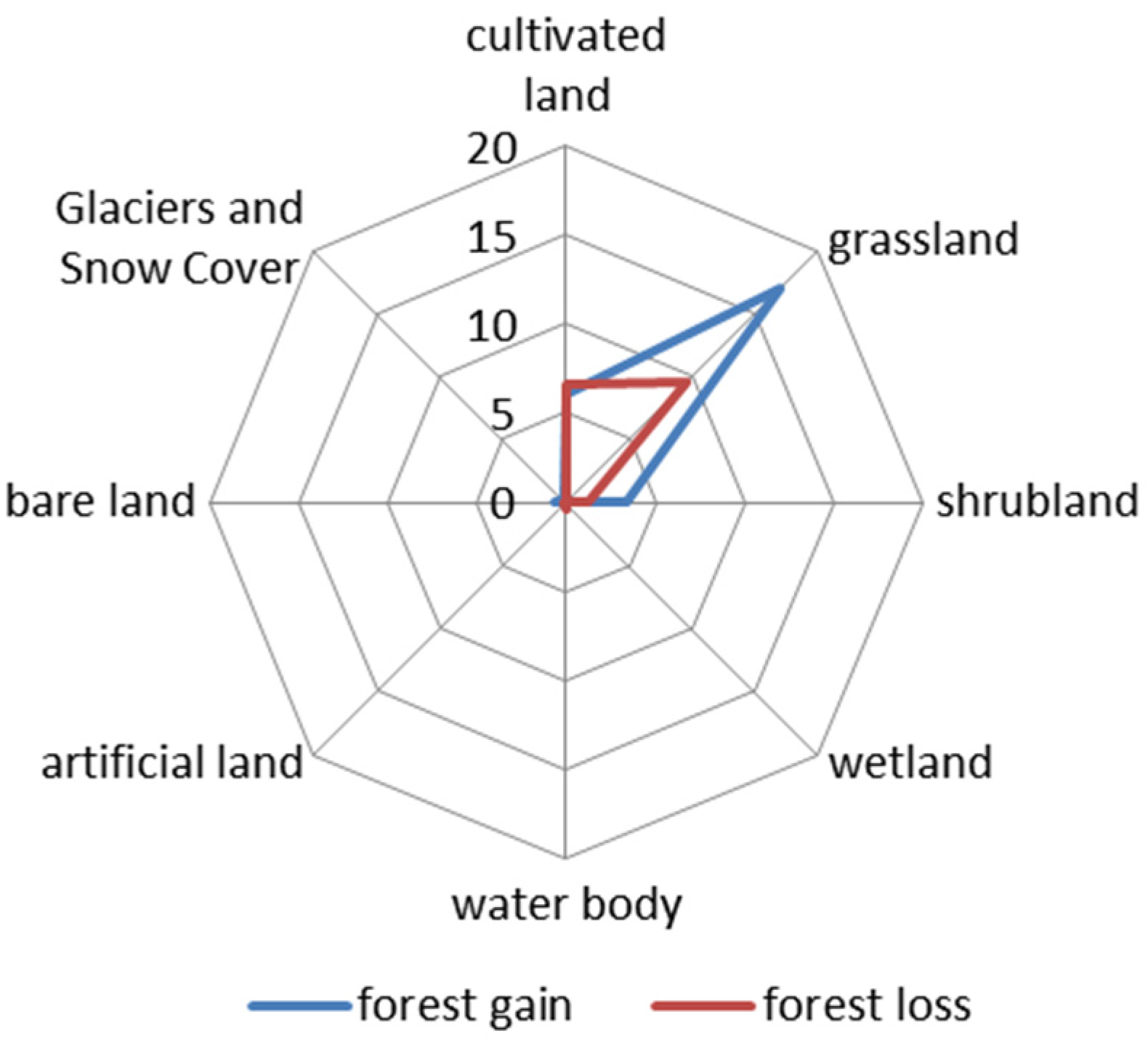
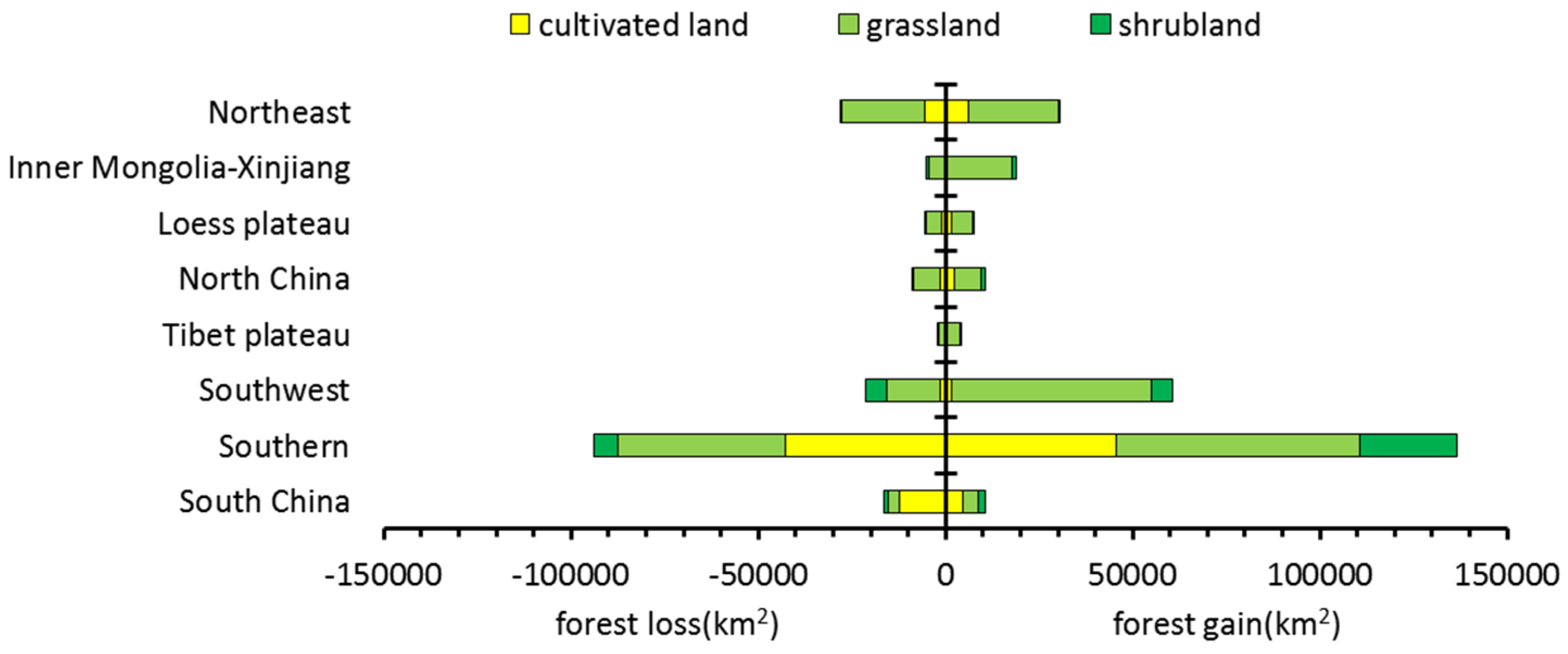
| Variable | Definition | Unit | Mean | Standard Deviation | Minimum | Maximum | Sample Size |
|---|---|---|---|---|---|---|---|
| forest2010 | Forest area in 2010 | km2 | 712.8 | 707.9 | 9.780 | 2292 | 1707 |
| forest2000 | Forest area in 2000 | km2 | 715.4 | 787.9 | 0.0100 | 4481 | 1707 |
| GDP | Per capita GDP in 2010 | thousand yuan | 21.08 | 15.98 | 2.790 | 116.1 | 1707 |
| GDP2 | Quadratic term of per capita GDP in 2010 | thousand yuan | 699.7 | 1407 | 7.760 | 13468 | 1707 |
| invest_forest | Forestry investment during 2000–2005 | billion yuan | 2.380 | 1.650 | 0.130 | 6.610 | 1707 |
| urbanrate | Urbanization rate in 2010 | % | 34.62 | 13.36 | 2.680 | 94.25 | 1707 |
| chan_tpop | Population variation during 2000–2010 | 10 thousand person | −0.440 | 5.870 | −32.18 | 40.58 | 1707 |
| chan_trpop | Rural population variation during 2000–2010 | 10 thousand person | −5.720 | 6.670 | −36.02 | 15.42 | 1707 |
| elev | Elevation | m | 763.9 | 637.5 | 2.400 | 1984 | 1707 |
| slope | Gradient | ° | 10.22 | 6.250 | 0.370 | 22.71 | 1707 |
| preci | Precipitation | mm | 979.8 | 480.9 | 120.9 | 2185 | 1707 |
| actemp | Accumulated temperature (≥0 °C) | °C | 46,947 | 16,183 | 4670 | 86,958 | 1707 |
| Forestry Division | 2000 | 2010 | Increase | Decrease | Variation | Rate of Change % |
|---|---|---|---|---|---|---|
| Tibetan Plateau | 3051.17 | 6352.95 | 5098.78 | 1797.00 | 3301.78 (4) | 108.21 |
| Inner Mongolia-Xinjiang | 25,801.00 | 40,899.85 | 21,039.64 | 5940.79 | 15,098.85 (3) | 58.52 |
| Southwest | 256,891.41 | 299,049.49 | 64,951.32 | 22,793.24 | 42,158.08 (2) | 16.41 |
| Loess plateau | 55,820.75 | 58,158.73 | 7619.49 | 5281.51 | 2337.98 (6) | 4.19 |
| Southern | 1,118,323.36 | 1,161,159.77 | 140,379.47 | 97,543.06 | 42,836.41 (1) | 3.83 |
| North China | 92,073.08 | 93,602.17 | 10,938.29 | 9409.20 | 1529.09 (7) | 1.66 |
| Northeast | 407,429.73 | 409,979.66 | 31,056.32 | 28,506.39 | 2549.93 (5) | 0.63 |
| South China | 147,482.94 | 141,419.98 | 11,280.40 | 17,343.36 | −6062.96 (8) | −4.11 |
| Province | 2000 | 2010 | Increase | Decrease | Variation | Rate of Change (%) |
|---|---|---|---|---|---|---|
| Shanghai | 2.5 | 9.5 | 9.5 | 2.5 | 7.1 (26) | 287.56 |
| Gansu | 29,030.2 | 52,454.6 | 26,180.6 | 2756.2 | 23,424.4 (2) | 80.69 |
| Qinghai | 1686.9 | 3018.6 | 2145.9 | 814.2 | 1331.7 (12) | 78.95 |
| Xinjiang | 19,340.0 | 23,352.8 | 8145.6 | 4132.8 | 4012.8 (6) | 20.75 |
| Hunan | 106,473.6 | 124,357.3 | 26,831.9 | 8948.1 | 17,883.7 (3) | 16.8 |
| Tianjin | 153.8 | 175.5 | 49.4 | 27.7 | 21.7 (24) | 14.11 |
| Sichuan | 188,103.4 | 213,617.7 | 46,517.0 | 21,002.7 | 25,514.3 (1) | 13.56 |
| Tibet | 108,922.3 | 123,041.2 | 24,472.0 | 10,353.1 | 14,119.0 (4) | 12.96 |
| Chongqing | 31,621.3 | 35,305.3 | 6833.5 | 3149.4 | 3684.0 (7) | 11.65 |
| Hubei | 81,669.2 | 88,166.2 | 11,526.6 | 5029.6 | 6497.0 (5) | 7.96 |
| Jiangsu | 1999.6 | 2149.2 | 445.2 | 295.7 | 149.5 (21) | 7.48 |
| Shandong | 3452.7 | 3637.5 | 616.3 | 431.5 | 184.9 (20) | 5.35 |
| Guizhou | 82,845.2 | 86,044.5 | 15,275.7 | 12,076.5 | 3199.2 (9) | 3.86 |
| Henan | 32,828.0 | 33,502.8 | 2345.7 | 1670.9 | 674.8 (15) | 2.06 |
| Hebei | 34,686.9 | 35,396.6 | 4389.4 | 3679.7 | 709.7 (14) | 2.05 |
| Beijing | 7020.9 | 7128.1 | 455.2 | 348.0 | 107.2 (22) | 1.53 |
| Shanxi | 42,265.1 | 42,889.5 | 3870.9 | 3246.5 | 624.4 (16) | 1.48 |
| Inner Mongolia | 129,972.1 | 131,863.0 | 12,943.0 | 11,052.2 | 1890.8 (11) | 1.45 |
| Yunnan | 225,945.5 | 229,162.9 | 27,595.3 | 24,377.9 | 3217.3 (8) | 1.42 |
| Heilongjiang | 179,434.2 | 181,415.8 | 13,916.8 | 11,935.2 | 1981.6 (10) | 1.1 |
| Shaanxi | 94,831.6 | 95,752.5 | 5743.2 | 4822.3 | 920.9 (13) | 0.97 |
| Guangdong | 99,085.8 | 99,657.1 | 8296.9 | 7725.6 | 571.3 (17) | 0.58 |
| Jiangxi | 98,725.3 | 99,198.9 | 8952.7 | 8479.1 | 473.6 (18) | 0.48 |
| Ningxia | 816.5 | 818.0 | 241.8 | 240.3 | 1.5 (27) | 0.18 |
| Guangxi | 158,029.4 | 158,251.7 | 10,167.4 | 9945.2 | 222.2 (19) | 0.14 |
| Taiwan | 24,123.2 | 24,132.9 | 905.0 | 895.3 | 9.7 (25) | 0.04 |
| Fujian | 82,475.8 | 82,500.3 | 6646.6 | 6622.0 | 24.5 (23) | 0.03 |
| Zhejiang | 57,435.7 | 57,429.9 | 4163.8 | 4169.7 | −5.8 (28) | −0.01 |
| Liaoning | 40,906.7 | 40,698.1 | 5127.4 | 5336.1 | −208.7 (29) | −0.51 |
| Jilin | 73,417.3 | 72,748.9 | 3361.5 | 4029.9 | −668.4 (31) | −0.91 |
| Anhui | 37,450.6 | 36,973.0 | 2488.3 | 2965.8 | −477.5 (30) | −1.28 |
| Hainan | 31,501.0 | 25,103.0 | 1635.4 | 8033.4 | −6398.0 (32) | −20.31 |
| Model East | Model Central | Model West | Model Total | |
|---|---|---|---|---|
| GDP | −2.645 ** | −0.594 | −1.930 ** | −2.157 *** |
| (−2.00) | (−0.38) | (−2.19) | (−2.86) | |
| GDP2 | 0.028 *** | 0.001 | 0.025 *** | 0.022 *** |
| (2.78) | (0.03) | (3.05) | (3.54) | |
| invest_forest | 0.792 | 71.056 *** | 0.435 | 5.267 ** |
| (0.09) | (2.93) | (0.17) | (2.33) | |
| urban_rate | −0.734 | −1.090 | −0.041 | −0.635 |
| (−0.98) | (−1.10) | (−0.14) | (−1.46) | |
| chan_tpop | 0.822 | 0.002 | 1.655 *** | 1.511 ** |
| (0.76) | (0.00) | (2.59) | (2.10) | |
| chan_trpop | −1.600 | −2.359 | −1.561 *** | −1.990 ** |
| (−1.23) | (−1.40) | (−2.79) | (−2.25) | |
| elev | 0.488 *** | 0.264 * | −0.0410 | 0.060 * |
| (3.23) | (1.75) | (−1.19) | (1.95) | |
| slope | 5.763 * | 12.391 *** | 2.687 ** | 6.654 *** |
| (1.74) | (3.07) | (2.35) | (5.16) | |
| preci | −0.034 | 0.181 *** | −0.00200 | 0.109 *** |
| (−0.64) | (2.63) | (−0.07) | (4.98) | |
| actemp | 0.003 ** | 0.008 ** | −0.002 *** | −0.001 |
| (2.18) | (2.22) | (−2.86) | (−1.10) | |
| forest2000 | 0.775 *** | 0.706 *** | 0.986 *** | 0.818 *** |
| (18.80) | (20.33) | (144.93) | (37.00) | |
| constant | −105.6 | −416.781 *** | 151.647 ** | −9.888 |
| (−0.94) | (−3.62) | (2.03) | (−0.39) | |
| R2 | 0.958 | 0.928 | 0.974 | 0.938 |
| N | 391 | 586 | 730 | 1707 |
| F | 716.7 | 409.4 | 3041 | 1339 |
© 2016 by the authors; licensee MDPI, Basel, Switzerland. This article is an open access article distributed under the terms and conditions of the Creative Commons Attribution (CC-BY) license (http://creativecommons.org/licenses/by/4.0/).
Share and Cite
Wang, J.; Xin, L.; Tan, M.; Wang, Y. Spatial Heterogeneity in Chinese Forest Area Change in the Early 21st Century. Forests 2016, 7, 232. https://doi.org/10.3390/f7100232
Wang J, Xin L, Tan M, Wang Y. Spatial Heterogeneity in Chinese Forest Area Change in the Early 21st Century. Forests. 2016; 7(10):232. https://doi.org/10.3390/f7100232
Chicago/Turabian StyleWang, Jiayue, Liangjie Xin, Minghong Tan, and Yahui Wang. 2016. "Spatial Heterogeneity in Chinese Forest Area Change in the Early 21st Century" Forests 7, no. 10: 232. https://doi.org/10.3390/f7100232






